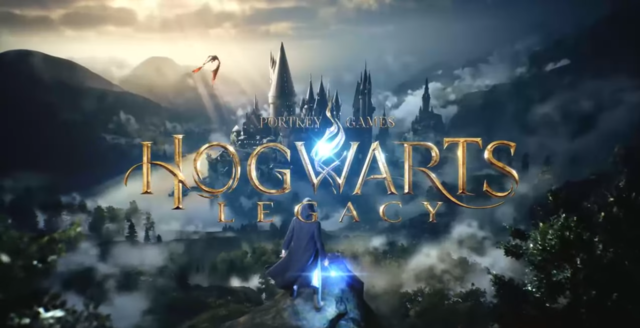‘Hogwarts Legacy’ is shallow, harmful
Wikimedia Commons
The cover image of “Hogwarts Legacy” with Hogwarts castle in the background. The game has some pretty big flaws, and it’s real-world harm detracts even more from the game.
March 23, 2023
“Hogwarts Legacy” is a fairly decent “Harry Potter” game buried beneath very real dark arts.
Developed by Avalanche Software and published by WB Games under its label Portkey Games, “Hogwarts Legacy” is a brand new action role-playing game based on the wizarding world of “Harry Potter” by J.K. Rowling.
The game takes place in 1890. You, the player, control a new fifth-year transfer student on their way to Hogwarts with their mentor Professor Eleazar Fig. This transfer student discovers that they’re in possession of a powerful ancient magic while spending their time at Hogwarts and discovers this magic goes even deeper in the world’s roots.
Soon, the student becomes a target for the goblin Ranrok, who’s in search of this magic left behind by four Keepers of Hogwarts’ past. Ranrok hopes to use this power to bring forth a goblin uprising in the wizarding world and collaborates with several dark arts users led by Victor Rookwood.
The protagonist must face all of this while ensuring they keep up with their herbology, flying and other studies at Hogwarts.
Before I go any further with the game’s contents, we must address the elephant in the room: J.K. Rowling.
Over the years, J.K. Rowling has gotten into hot water due to racist and transphobic beliefs and comments, namely in a public manifesto regarding sex and gender issues on her official website, that have bled deeply into her work. This is true for this game as well with its clear anti-semitic tropes within its goblin characters.
Part of the antagonists, Ranrok and his goblin faction, plan in this game very much parallels blood libel. Blood libel is an anti-semitic superstition accusing Jews of kidnapping and murdering Christian children to use their blood for ritualistic purposes.
Part of Ranrok’s evil scheme is essentially the exact same as he wants the student’s, a child’s, blood for a ritual that will help him in his rebellion. To make matters worse, the goblins are depicted in-game using an instrument that strikes an eerie resemblance to a shofar, a ram’s horn constructed into a bugle instrument used in Jewish religion.
Because of these issues, many have called for a boycott, not only against this game, but also the “Harry Potter” franchise as a whole, despite Rowling not being involved with the game in any direct manner.
“As a society, we are sort of normalizing the negative comments she’s making by continuing to support and fund the [Harry Potter] franchise. However, it’s a beloved franchise that’s been very meaningful to many people,” Kimberly Shotick, an advisor for NIU’s Gaming for All organization said regarding the boycott. “It’s complicated on a personal level. I think individuals have choices to make. However on a societal level, we are completely free to criticize it and we have that right and we should as a society.”
Many sources like Wired and Vulture believe that the game cannot be looked at outside of the controversy. “Nothing with a Wizarding World stamp on it can be viewed outside the context of it being a product of Dame J. K. Rowling,” Wired claimed in its 1/10 scored review of the game.
Vulture declared, “The feverishly anticipated Harry Potter video game can’t muster the fantasy escapism it so desperately wants.”
The artistry in the game is exemplary. Whether or not the artistry of the game can out-shadow the controversy is up for the individual to decide. Controversy aside, the question still remains: Is “Hogwarts Legacy” a worthy game to don the Harry Potter name?
The answer for the most part is … kind of.
In the school of Hogwarts, you’re sorted into one of four houses from the books. However, you can choose a different house if you don’t like the house you’re sorted into. You’re only asked at least two questions and are randomly assigned a house. I found myself sorted into Ravenclaw.
As for your classes, you have up to eight to attend and learn spells and other abilities from. However, the only classes I found to be remotely interesting were Defense Against the Dark Arts and Flying. Defense Against the Dark Arts has you learning numerous offensive spells such as Levioso.
Flying class is the Hogwarts equivalent to driver’s ed; just swap the car for a broomstick. Unfortunately, the player can’t play quidditch which is a missed opportunity, as much of a missed opportunity as not including multiplayer – local or online.
Other activities include dueling clubs where you can practice your dueling skills and spells, Merlin trials that provide puzzles and a good challenge in your exploration and visiting the town of Hogsmeade full of various shops.
It may sound like fun, but it’s all weighed down by one-dimensional characters as well as clunky gameplay and performance. I played this on PC and even on the lowest settings, the game stuttered and took ages to load things as simple as the pause menu.
As for the gameplay, battles can get hectic but also repetitive. Despite having a good number of spells plus charms, the combat and enemy types never really change all that much.
Characters pale in comparison to the source material such as the knock-off Draco Malfoy known as Sebastian Sallow, or another transfer student named Natsai Onai from Uagadau. And of course there’s the aforementioned villains and their whole can of anti-semitic worms.
Alas, “Hogwarts Legacy” has imaginable potential that its real world harm squanders. It’s a shame as this could’ve been the perfect game for “Harry Potter” fans, but now it’s nothing more than another footnote in this series’ lost soul, thanks in part to its creator.







